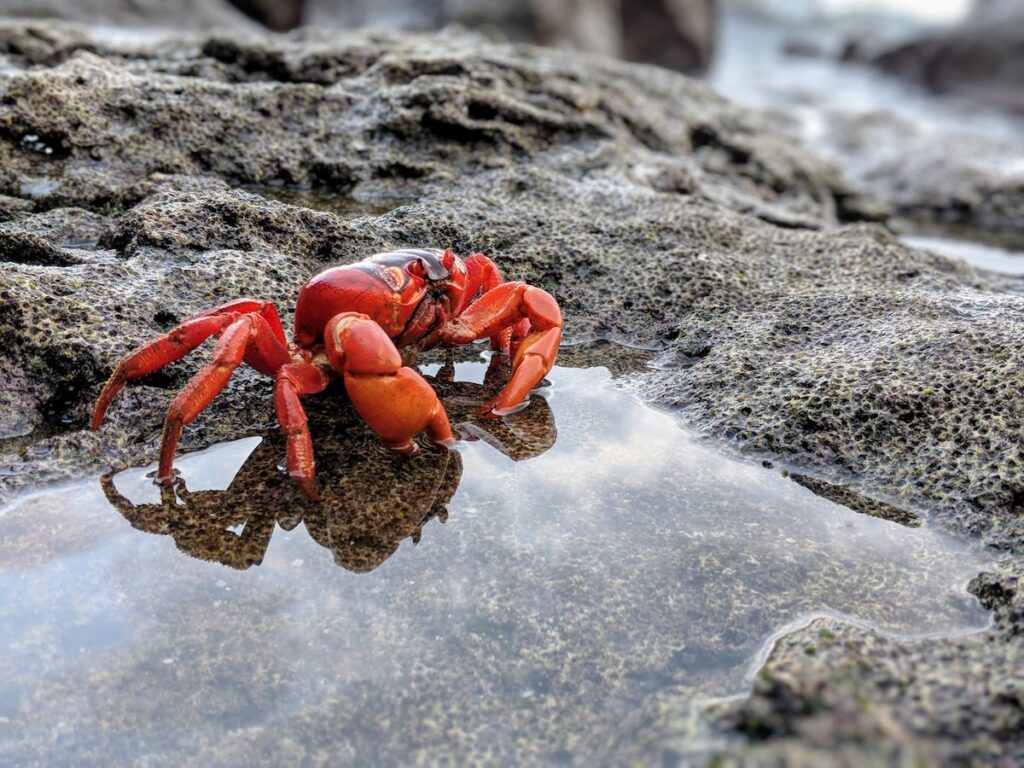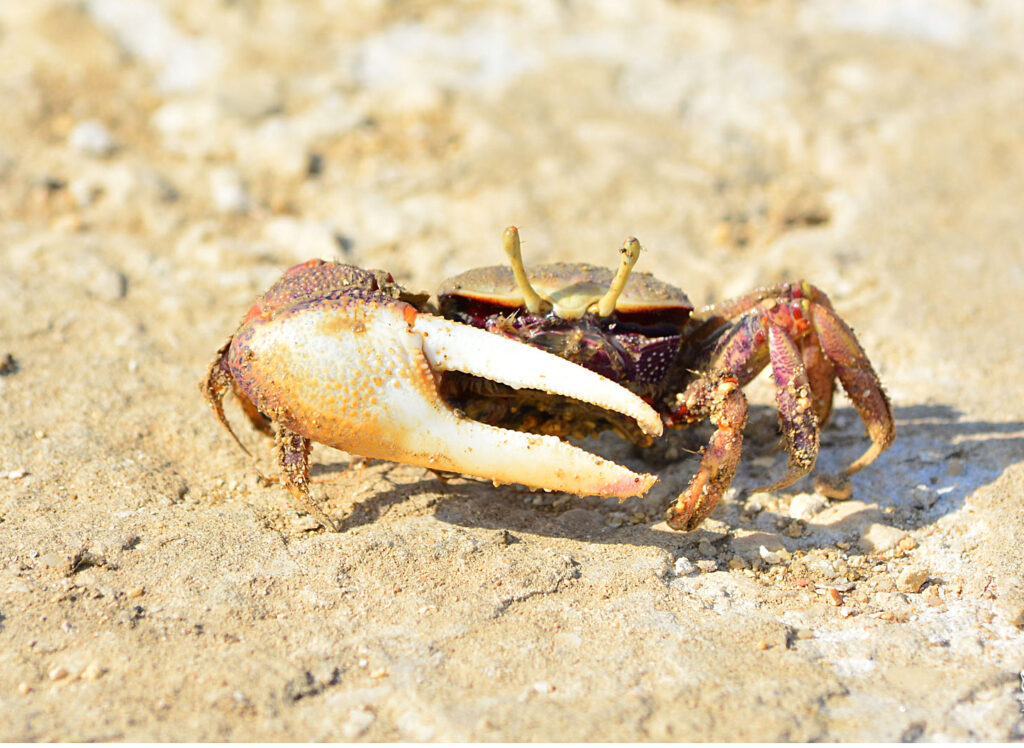The Crab is a creature that is usually found on beaches anywhere in the world. It presents quite varied sizes among its different species and tends to live in brackish waters. It is generally omnivorous, although certain varieties have specialized as carnivorous or herbivorous. To know what Crabs eat according to each species, we invite you to continue reading this article.

What do Crabs eat?
Crabs are a group of crustaceans that belong to the order Decapoda. This order includes some 15.000 different species, including prawns and prawns. Crabs play an essential role within their ecosystems, both as important predators and as the favorite prey of numerous aquatic carnivores. In addition to this, as we will examine later, some of them are essential for the recycling of organic matter.
Characteristics of Crabs
The following are the most outstanding physical and behavioral characteristics of crabs:
- tagmas: its body is separated into the cephalothorax, which includes the head and part of the thorax, and the pleon, which is what is often known as the “tail”. However, the latter can be greatly reduced.
- exoskeleton: Crabs are creatures with an exoskeleton, which is an external skeleton made up of chitin. Added to it, it can be composed of calcium carbonate and appear very hardened, thus constituting a kind of shell.
- Young: as they grow, the exoskeleton “is small for them”. Therefore, like all arthropods, they shed it and form a new one.
- Pins: Like all decapods, crabs have 10 pairs of legs. In the cephalothorax they have 5 pairs. The first ones use them to feed and the rest are to move, that is, they use them to walk. In the pleon they have another 5 pairs of legs that they use to swim.
- Tweezers: regularly, these animals have a pair of legs transformed into pincers. They serve to defend themselves and feed themselves. They are usually smaller in females.
- integumentary gas exchange: crabs breathe through their skin thanks to the gills they have at the base of their legs, which are protected by the exoskeleton.
- gastric mill: this is the name given to the stomach of crabs. They are structures that crumble and sift the food. When it comes to understanding what their feeding process is like, this is one of the most relevant characteristics of crabs.
- Senses: crabs have compound eyes that are sessile or arranged in a mobile appendage. They also have sensitive appendages and two pairs of antennae, thanks to which they recognize their environment.
- oviparous reproduction: These creatures reproduce by laying eggs. The female carries them and incubates them until they hatch.
- indirect development: from the egg emerges a larva called "nauplius" that leads a planktonic existence. This larva undergoes a process of metamorphosis until it becomes the adult that we all recognize.
- benthic habitat: With some exceptions, crabs inhabit riverbeds or the seabed. This peculiarity can guide us about what the crabs eat.
Food of the River Crabs
The families Astacidae, Parastacidae and Cambaridae are usually called crayfish. These crustaceans live at the bottom of rivers and other freshwater bodies, where they hide from predators such as mustelids. As part of their diet, all kinds of organic matter available in the bed are included. They are omnivorous creatures and can gobble up algae, modest invertebrates, fish, and even carrion. Therefore, they are of great importance in the recycling of the corpses that are deposited in the bed, thus avoiding their accumulation.
Among some of the species of crayfish we can distinguish:
- European crayfish (Austropotamobius pallipes)
- American Red Crab (Procambarus clarkii)
What is the Food of Sea Crabs?
Sea crabs make up a very varied group of crustaceans. In it we can find numerous kinds of crabs, such as hermits (Paguroidea), spiny lobsters (Palinuridae) and most of the brachyurans (Brachyura).
Knowing what sea crabs eat is not an easy task, since the diet of these animals will depend on the species, their environment and their way of life. Therefore, to know what sea crabs eat, we must group them according to their type of food, that is, if they are carnivores, herbivores or omnivores.
Carnivores
Carnivorous crabs are usually benthic, that is, they feed on animals that populate the seabed, such as modest crustaceans and molluscs. However, some have been known to eventually eat algae. Among the species of carnivorous crabs are:
- Crab (Cancer pagurus)
- Blue snow crab (Chionoecetes opilio)
herbivorous
These marine creatures feed essentially on the leaves and shoots of plants, both offshore and coastal. These include algae, seagrasses and mangroves. However, to supplement their diet they can eat modest invertebrates in very small quantities. As an example of this herbivorous marine animal we have the mangrove crab (Aratus pisonii). It is an arboreal creature, which is why certain authors classify it as semi-terrestrial.
omnivores
The varied diet available to omnivorous crabs allows them to adapt very well to different ecosystems. As part of the diet of the crabs that belong to this category, we can get tiny invertebrates, algae and even carrion. As examples of omnivorous sea crabs we can cite the following:
- Blue crab (Callinectes sapidus)
- Coconut crab (Birgus latro)
What do Land Crabs eat?
We can say that those that spend most of their life cycle out of the water are classified as land crabs. However, their larvae are aquatic and the females return to the sea to spawn. Added to this, they require living in humid areas so that their gills stay hydrated. Land crabs are usually herbivorous creatures. Their diet is based on fruits and leaves, although they also frequently feed on carrion and tiny invertebrates.
As some of the species of land crabs we can mention:
- Red Land Crab (Gecarcinus lateralis)
- Blue land crab (Cardisoma guanhumi)
How do Aquarium Crabs sustain themselves?
Crabs are creatures that should live in their natural state and as part of their ecosystem, not in an aquarium. However, for various reasons, sometimes we find ourselves in the need to take care of a crab that we cannot return to its home. If this is your situation and you have wondered what aquarium crabs eat, we are going to provide you with some clues.
The diet of aquarium crabs will depend on their environment, way of life and which species they belong to. The most convenient thing is to be very well informed about their natural diet and try to imitate it. Only in this way can proper nutrition be guaranteed. If you still have doubts, the right thing to do is ask for the advice of a professional who can guide us.
As part of the variety of crabs that we most often see in aquariums are:
- European fiddler crab (Uca tangeri): it is a semi-terrestrial crustacean, with omnivorous feeding whose diet is primarily made up of sediments abundant in nutrients, such as microalgae. As part of their diet we can also find marsh plants, litter and carrion.
- Red land crab (Neosarmatium meinerti): we are talking about a saltwater crab, arboreal in its adulthood. Equally omnivorous, although it eats, particularly mangrove leaves and shoots. It can also feed on leaf litter, algae and tiny invertebrates.
- Rainbow crab (Cardisoma armatum): is a land crab that feeds essentially on leaves, fruits, flowers, beetles and other insects.
- Panther crab (Parathelphusa pantherina): it is a freshwater crustacean and, therefore, omnivorous that eats everything.
Curiosities
- The crab's teeth are located in its stomach.
- The largest crab known to date was found in Maryland. A male of a length of 9 inches.
- After losing its claw, a crab can grow it back.
- Crabs are also called decapods, since they have ten (deca) legs (pods). The first pair of legs are shown as pincers, biologically called chelae.
- Males have narrow abdomens, while females have a broader abdomen.
- The Japanese spider crab can show a separation between legs of 3 to 4 meters, which can reach 8 meters when it has extended them.
- The Japanese spider crab, in addition to being the oldest, is also believed to be the one that lives the deepest, as well as the one with the longest life expectancy.
- Hermit crabs, king crabs, horseshoe crabs, and porcelain crabs are not true crabs, since they are not decapods.
- Fiddler crabs have a single huge claw on one side, which they can raise in an action that seems to mimic a person playing the violin.
- The most colorful crab in the world is the Sally Lightfoot crab. It exhibits red, orange, yellow and white colors.
- Crabs can stay on land, as long as they can keep their gills moist. This is possibly one of the reasons why you will see the crabs quite close to the waves, on the shore.
- The varieties of crabs that are most eaten around the world are the Japanese blue crab or the horse crab.
- Crabs are usually boiled while still alive, and contrary to popular myth, both crabs and lobsters can sense pain and often don't forget to survive.
- In most East Asian cultures, roe, often referred to as ovarian egg masses, are still eaten as they are considered an excellent source of omega-3 fatty acids.
- Crabs are extraordinary communicators. They generally communicate by drumming their claws or shaking their pincers.
- Crabs are famous for working as a team. They work together to provide food as well as to protect their families. In the mating season, the males look for a comfortable place for the female to release her eggs.
- Walking and swimming to the sides of the crabs usually draws attention.
- You can tell the sex of the crab by looking under its shell. Females usually show a dome, while males show a phallic exterior.
Other articles that we would like to recommend are:




